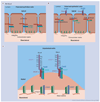Muc4/MUC4 functions and regulation in cancer
- PMID: 20001800
- PMCID: PMC2825673
- DOI: 10.2217/fon.09.125
Muc4/MUC4 functions and regulation in cancer
Abstract
The membrane mucin MUC4 (human) is abundantly expressed in many epithelia, where it is proposed to play a protective role, and is overexpressed in some epithelial tumors. Studies on the rat homologue, Muc4, indicate that it acts through anti-adhesive or signaling mechanisms. In particular, Muc4/MUC4 can serve as a ligand/modulator of the receptor tyrosine kinase ErbB2, regulating its phosphorylation and the phosphorylation of its partner ErbB3, with or without the involvement of the ErbB3 ligand neuregulin. Muc4/MUC4 can also modulate cell apoptosis via multiple mechanisms, both ErbB2 dependent and independent. Muc4/MUC4 expression is regulated by multiple mechanisms, ranging from transcriptional to post-translational. The roles of MUC4 in tumors suggest that it may be valuable as a tumor marker or target for therapy.
Figures


Similar articles
-
Mechanistic and signaling analysis of Muc4-ErbB2 signaling module: new insights into the mechanism of ligand-independent ErbB2 activity.J Cell Physiol. 2010 Sep;224(3):649-57. doi: 10.1002/jcp.22163. J Cell Physiol. 2010. PMID: 20432461 Free PMC article.
-
MUC4 involvement in ErbB2/ErbB3 phosphorylation and signaling in response to airway cell mechanical injury.J Cell Biochem. 2009 May 1;107(1):112-22. doi: 10.1002/jcb.22106. J Cell Biochem. 2009. PMID: 19288496
-
Muc4/sialomucin complex, the intramembrane ErbB2 ligand, induces specific phosphorylation of ErbB2 and enhances expression of p27(kip), but does not activate mitogen-activated kinase or protein kinaseB/Akt pathways.Oncogene. 2002 Oct 24;21(49):7524-32. doi: 10.1038/sj.onc.1205970. Oncogene. 2002. PMID: 12386815
-
Muc4/sialomucin complex, the intramembrane ErbB2 ligand, in cancer and epithelia: to protect and to survive.Prog Nucleic Acid Res Mol Biol. 2002;71:149-85. doi: 10.1016/s0079-6603(02)71043-x. Prog Nucleic Acid Res Mol Biol. 2002. PMID: 12102554 Review.
-
Muc4/sialomucin complex in the mammary gland and breast cancer.J Mammary Gland Biol Neoplasia. 2001 Jul;6(3):323-37. doi: 10.1023/a:1011327708973. J Mammary Gland Biol Neoplasia. 2001. PMID: 11547901 Review.
Cited by
-
Clinicopathological characteristics and prognosis of signet ring cell carcinoma of the gallbladder.BMC Gastroenterol. 2021 Jun 6;21(1):248. doi: 10.1186/s12876-021-01831-4. BMC Gastroenterol. 2021. PMID: 34090347 Free PMC article.
-
Mucin-4: A novel marker for oral cancer.J Oral Maxillofac Pathol. 2019 Jan-Apr;23(1):49-53. doi: 10.4103/jomfp.JOMFP_175_16. J Oral Maxillofac Pathol. 2019. PMID: 31110416 Free PMC article.
-
Cell Adhesion Molecules in Plasticity and Metastasis.Mol Cancer Res. 2021 Jan;19(1):25-37. doi: 10.1158/1541-7786.MCR-20-0595. Epub 2020 Oct 1. Mol Cancer Res. 2021. PMID: 33004622 Free PMC article. Review.
-
Proteomic analysis of brain metastatic lung adenocarcinoma reveals intertumoral heterogeneity and specific alterations associated with the timing of brain metastases.ESMO Open. 2023 Feb;8(1):100741. doi: 10.1016/j.esmoop.2022.100741. Epub 2022 Dec 16. ESMO Open. 2023. PMID: 36527824 Free PMC article.
-
ErbB2 stabilizes epidermal growth factor receptor (EGFR) expression via Erk and Sprouty2 in extracellular matrix-detached cells.J Biol Chem. 2011 Jan 7;286(1):79-90. doi: 10.1074/jbc.M110.169821. Epub 2010 Oct 18. J Biol Chem. 2011. PMID: 20956544 Free PMC article.
References
-
- Sherblom AP, Buck RL, Carraway KL. Purification of the major sialoglycoproteins of 13762 MAT-B1 and MAT-C1 rat ascites mammary adenocarcinoma cells by density gradient centrifugation in cesium chloride and guanidine hydrochloride. J. Biol. Chem. 1980;255:783–790. - PubMed
-
-
Sherblom AP, Carraway KL, et al. A complex of two cell surface glycoproteins from ascites mammary adenocarcinoma cells. J. Biol. Chem. 1980;255:12051–12059. ▪ First isolation and characterization of rat Muc4, then called sialomucin complex.
-
-
-
Porchet N, Nguyen VC, Dufosse J. Molecular cloning and chromosomal localization of a novel human tracheobronchial mucin cDNA containing tandemly repeated sequences of 48 base pairs. Biochem. Biophys. Res. Commun. 1991;175:414–422. ▪▪ First partial clone of human MUC4 and designation as member of the mucin ‘family’
-
-
- Sheng Z, Wu K, Carraway KL, Fregien N. Molecular cloning of the transmembrane component of the 13762 mammary adenocarcinoma sialomucin complex. A new member of the epidermal growth factor superfamily. J. Biol. Chem. 1992;267:16341–16346. - PubMed
-
- Wu K, Fregien N, Carraway KL. Molecular cloning and sequencing of the mucin subunit of a heterodimeric, bifunctional cell surface glycoprotein complex of ascites rat mammary adenocarcinoma cells. J. Biol. Chem. 1994;269:11950–11955. - PubMed
Publication types
MeSH terms
Substances
Grants and funding
LinkOut - more resources
Full Text Sources
Research Materials
Miscellaneous
